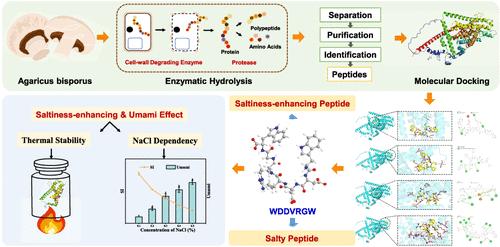Molecular Characteristics and Thermal Stability of Salty/Saltiness-Enhancing Peptides from Enzymatic Hydrolysates of Agaricus bisporus
IF 6.2
1区 农林科学
Q1 AGRICULTURE, MULTIDISCIPLINARY
引用次数: 0
Abstract
Agaricus bisporus peptides with a saltiness-enhancing effect (24%) were obtained through favorable enzymatic hydrolysis conditions. To identify the molecular characteristics of saltiness-enhancing peptides, A. bisporus protein was extracted and hydrolyzed under the selected optimal conditions. The resulting peptides were further separated through ultrafiltration and gel chromatography and characterized by liquid chromatography-tandem mass spectrometry (LC-MS/MS). Molecular docking was then performed with the transmembrane channel-like 4 (TMC4), leading to the identification of four key peptides: WDDVRGW, GRGGYFDEF, ARSIGVS, and WDEVRGE. The synthetic WDDVRGW was proved to be a salty peptide and saltiness-enhancing peptide. The aqueous solution of 0.05% WDDVRGW displayed a saltiness of 3.66 ± 0.13, and 0.005% WDDVRGW with 0.4% NaCl solution presented a saltiness of 4.93 ± 0.05, showing a saltiness enhancement of 11.4%. Both synthetic and enzymatic hydrolyzed peptides exhibited higher saltiness-enhancing effects at lower NaCl concentrations. A. bisporus peptides can maintain a high saltiness-enhancing effect (>15%) after the thermal process at 105–125 °C for 120 min, exhibiting desirable thermal stability. The initial pH of 8.0 in the thermal reaction solution was more beneficial to the formation of saltiness-enhancing peptides.

双孢蘑菇酶解产物增咸肽的分子特性和热稳定性
通过良好的酶解条件,获得了具有24%增盐作用的双孢蘑菇肽。以双孢酵母为研究对象,在最佳条件下提取双孢酵母蛋白并进行水解。所得多肽通过超滤和凝胶层析进一步分离,并通过液相色谱-串联质谱(LC-MS/MS)进行表征。然后与跨膜通道样4 (TMC4)进行分子对接,鉴定出四个关键肽:WDDVRGW、GRGGYFDEF、ARSIGVS和WDEVRGE。经实验证明,合成的WDDVRGW是一种咸味增强肽。0.05% WDDVRGW水溶液的咸度为3.66±0.13,0.005% WDDVRGW加入0.4% NaCl溶液的咸度为4.93±0.05,咸度增强11.4%。在较低的NaCl浓度下,合成肽和酶解肽均表现出较高的盐性增强效应。双孢杆菌肽在105-125℃加热120 min后仍能保持较高的增盐效果(>15%),表现出良好的热稳定性。初始pH为8.0的热反应溶液更有利于盐性增强肽的生成。
本文章由计算机程序翻译,如有差异,请以英文原文为准。
求助全文
约1分钟内获得全文
求助全文
来源期刊
CiteScore
9.90
自引率
8.20%
发文量
1375
审稿时长
2.3 months
期刊介绍:
The Journal of Agricultural and Food Chemistry publishes high-quality, cutting edge original research representing complete studies and research advances dealing with the chemistry and biochemistry of agriculture and food. The Journal also encourages papers with chemistry and/or biochemistry as a major component combined with biological/sensory/nutritional/toxicological evaluation related to agriculture and/or food.

 求助内容:
求助内容: 应助结果提醒方式:
应助结果提醒方式:


